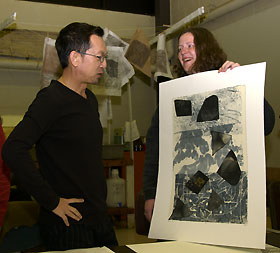|
This is an archived article.
For the latest news, go to the
Advance Homepage
For more archives, go to the Advance Archive/Search Page. | ||
|
UConn Hosts Week-Long For Argentine artist Alicia Candiani, opening the frontiers of printmaking is a necessary response to the 21st century's political and artistic world transformations. Interprint 2003, an international, invitational, printmaking symposium recently hosted by the School of Fine Arts and the Department of Art and Art History, did just that. The symposium brought together student artists and faculty representing art institutions from 12 different countries for a weeklong series of workshops, lectures, critiques, and exhibitions.
Printmaking is capable of absorbing, responding, and reacting to the changes being impressed on artists and artistic practices in the new millennium, said Candiani, keynote speaker at the symposium. These changes arise both from the global context and from ever-changing technology. "As in pidgin languages, which are a mixture of two or more languages, contemporary printmaking has evolved," she said. "Artists have always appropriated reproduction methods and have 'reinvented' them, 'speaking' another language, one for which they were not originally created. "In these times, the technological processes available to us are radically different and infinitely more complex than those available 450 years or even 50 years ago," Candiani said. "New visual forms have been possible due to the new technologies, and artists have been forced to address issues that are as complex as the technological tools at their disposal." Printmaking has been around for five centuries and today's students need a wide variety of tools and skills to draw from, said another speaker, Vulindlela Nyoni of South Africa. Nyoni said printmaking generally covers four areas: relief (woodcut, linoleum cut), intaglio (etching), silkscreen, and lithography, while computer-generat ed imagery has progressively established its own place. "The toolbox for today's printmaker is much larger than it was 25 years ago," he said. "This is a critical time for increasing our understanding of printmaking as a fine art medium," says Gus Mazzocca, professor in UConn's Department of Art and Art History. "Some of the most interesting and inventive work in printmaking today combines traditional with newer digital technologies." Mazzocca is one of the founders of Interprint, a co-operative project that began between five art institutions from the USA, Ireland, Poland, England, and the Netherlands to bring together students and faculty from different cultures and different printmaking traditions to work together and share ideas, skills and techniques. The first Interprint project was hosted by the Art Academy in Maastricht, Netherlands in 1998. This year's symposium featured interactive, hands-on workshops, led by distinguished visiting artists who demonstrated a variety of techniques, including monotype printmaking, Japanese woodblock printing, collographic printmaking, illustration, photo etching, relief printing, color intaglio printing, stone lithography, digital approaches, offset printing, and book arts. Some of the artists also presented several lectures discussing the interplay of technology, media, and popular culture as they influence contemporary printmaking. Elizabeth Ingram from Canada and Thavorn Ko-Udomvit of Thailand led an experimental workshop for students that combined photographic and digital print processes with traditional silkscreen and water-based woodcut printmaking techniques. "This kind of experience works to open you up, shake you out of old habits," said Ingram. Added Ko-Udomvit, "artists are always hungry for new ideas. This experience provided us an opportunity to show each other how we do it." As at earlier conferences, students from each institution created editions of 100 prints, which were assembled into a portfolio box and exhibited during Interprint 2003. The artists enjoyed their cross-cultural exchange. "I had never met artists from another country before," noted UConn junior Sarah Kuchta, who hosted art student Nontombeca N Tombela from Durban, South Africa. Kuchta said they shared personal stories as well as ideas about art and culture. Kuchta said she now plans to visit South Africa. "Their culture is so different but it doesn't seem so foreign now. And with a friend to go see, it's given me an accessible way to go and experience their culture." "Our goal was to encourage the exchange of ideas and experiences between artists, educators, and students," said Laurie Sloan, a professor of printmaking in the Department of Art and Art History, one of the organizers of the UConn Interprint symposium. "We wanted the participants, for one week, to become intensely involved with printmaking and be aware of different cultural visions and artistic approaches from other parts of the world." |

